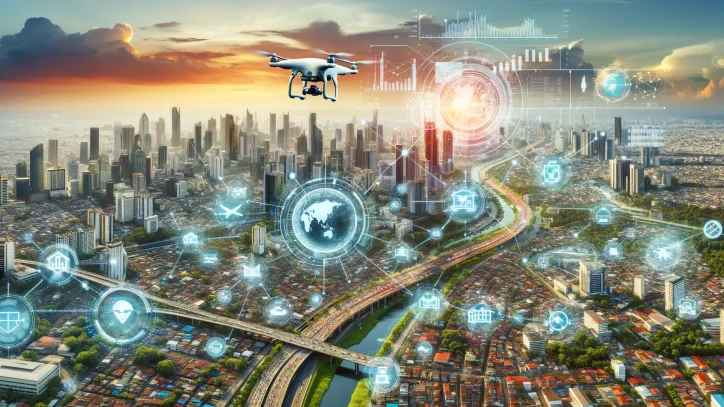The construction industry has long been associated with bricks, steel, and heavy machinery. However, beneath this traditional façade, a technological revolution is transforming how we build. From design and planning to execution and monitoring, construction is increasingly driven by digital innovations.
One of the most transformative tools in this shift is the GNSS device, which offers precise location data and plays a critical role in reshaping the way construction projects are approached and completed. These devices are enabling construction professionals to work with unprecedented accuracy, efficiency, and insight.
Geospatial technology, encompassing both GNSS and Geographic Information Systems (GIS), is no longer a niche tool used solely by surveyors and cartographers. Its integration into construction workflows is changing the way projects are managed, from the initial site assessment to the final build. The precision and real-time data provided by these technologies are invaluable in an industry where even minor errors can lead to significant setbacks. As construction projects become increasingly complex and interconnected, the ability to leverage detailed geospatial data is not just an advantage—it’s a necessity.
The Power of Precision: GNSS in Construction
The role of GNSS in construction extends far beyond basic location tracking. Modern GNSS devices are capable of delivering centimeter-level accuracy, which is crucial for tasks such as site surveying, machine control, and asset management. This precision enables construction teams to ensure that every element of a project is built exactly according to plan, reducing the likelihood of costly rework and delays.
For example, in large-scale infrastructure projects like highways or bridges, the placement of each structural component must be precisely aligned with the overall design. Even a small deviation can have significant consequences, potentially compromising the safety and durability of the structure. GNSS devices provide the real-time positioning data necessary to place these components with absolute precision, ensuring that the final product meets all specifications.
Beyond individual projects, GNSS technology is also transforming how we think about construction on a larger scale. It allows for the seamless integration of new developments into existing infrastructure, supporting the creation of more cohesive and functional urban environments. By providing accurate data on the location and dimensions of buildings, roads, and utilities, GNSS helps planners and engineers make informed decisions about where and how to build. This capability is particularly valuable in densely populated areas, where space is limited and the margin for error is small.
GIS: Visualizing and Managing Complex Data
While GNSS provides precise location data, GIS offers a powerful platform for visualizing and analyzing this information in context. GIS allows construction professionals to integrate spatial data from multiple sources, creating detailed maps and models that can be used for planning, monitoring, and decision-making. This capability is invaluable in complex projects where multiple variables—such as terrain, weather, and existing infrastructure—must be considered.
One of the key benefits of GIS is its ability to provide a comprehensive view of a project site. By overlaying different data layers, such as topography, land use, and transportation networks, GIS enables project teams to see the bigger picture and identify potential challenges before they arise. For example, a construction team planning a new housing development could use GIS to analyze factors such as soil stability, flood risk, and proximity to public services. This holistic approach not only helps to optimize the design but also ensures that the project is sustainable and well-integrated into its surroundings.
GIS is also instrumental in managing large-scale infrastructure projects that span multiple sites or jurisdictions. By centralizing all relevant data in a single platform, GIS facilitates collaboration among different teams and stakeholders, reducing the risk of miscommunication and ensuring that everyone is working with the same information. This capability is particularly important in projects that involve multiple phases or contractors, where effective coordination is essential to keeping the project on track.
Beyond Construction: GNSS and GIS in Urban Development
The influence of geospatial technology extends far beyond the construction site. GNSS and GIS are also playing a pivotal role in shaping the cities and communities of the future. As urban areas continue to expand and evolve, the need for smart, data-driven planning is becoming increasingly important. Geospatial technology provides the tools needed to design, build, and manage urban environments that are not only functional but also resilient and sustainable.
One of the most exciting applications of GNSS and GIS in urban development is in the creation of digital twins—virtual models of physical spaces that can be used for planning and analysis. Digital twins allow city planners and engineers to simulate different scenarios and assess the potential impact of new developments before they are built. For example, they can model how a new high-rise building might affect local traffic patterns, or how changes in land use could influence flood risk. This capability enables more informed decision-making and helps to prevent costly mistakes.
Geospatial technology is also playing a crucial role in the management of public infrastructure. By providing accurate, up-to-date data on the condition of roads, bridges, and utilities, GNSS and GIS enable municipalities to prioritize maintenance and repairs more effectively. This proactive approach not only reduces costs but also helps to prevent disruptions and improve the overall quality of life for residents.
In addition, GNSS and GIS are supporting the development of smart cities—urban areas that use technology to improve efficiency, sustainability, and the well-being of their inhabitants. From optimizing energy use in buildings to managing public transportation systems, geospatial technology provides the data and insights needed to make cities smarter and more livable. As more cities adopt these technologies, we can expect to see a new generation of urban environments that are better equipped to meet the challenges of the future.
Bridging the Gap: From Technology to Tradition
Despite the clear benefits of geospatial technology, its adoption in the construction industry has not been without challenges. Many construction professionals are accustomed to traditional methods and may be hesitant to embrace new tools and workflows. To fully realize the potential of GNSS and GIS, it is essential to bridge the gap between technology and tradition.
One way to do this is through education and training. By providing construction workers and managers with the knowledge and skills they need to use geospatial technology effectively, companies can ensure that their teams are prepared to take full advantage of these tools. This includes not only technical training but also a broader understanding of how geospatial data can be used to improve project outcomes.
Another important factor is integration. Rather than viewing geospatial technology as a replacement for traditional methods, it should be seen as a complement. For example, GNSS can be used alongside traditional surveying techniques to verify measurements and improve accuracy. By integrating new and old methods in this way, construction professionals can build on their existing expertise while also benefiting from the latest technological advancements.
A New Era for Construction
The construction industry is entering a new era, driven by the power of geospatial technology. From the precise positioning provided by GNSS devices to the comprehensive data analysis enabled by GIS, these tools are transforming the way we build. As the technology continues to evolve, its impact on construction—and on the cities and communities we create—will only grow.
For construction professionals, this transformation represents both a challenge and an opportunity. By embracing geospatial technology and integrating it into their workflows, they can unlock new levels of efficiency, precision, and innovation. As we look to the future, it is clear that the unseen power of geospatial technology will play a critical role in building a better world.

Ruby Stauffer is a prominent technology blogger known for her insightful analysis and in-depth reviews of the latest tech trends and gadgets. Her blog has become a go-to resource for tech enthusiasts seeking reliable information and expert opinions on the ever-evolving world of technology.

